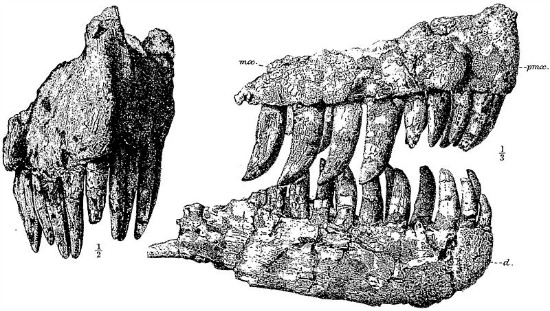What is Genyodectes?
A set of partial jaws hold an important place in the history of South American paleontology, but what sort of dinosaur do they represent?
![]()

An illustration showing the only known bones from Genyodectes. Art in Woodward, 1901, image from Wikipedia.
Paleontologists are naming new dinosaurs at an astonishing rate. In fact, they’re only just begun to skim the diversity of dinosaurs preserved in the world’s Mesozoic formations–hundreds of unknown dinosaur species are undoubtedly hiding in stone. But even among dinosaurs that have a formalized identity, there are many that we know relatively little about. Among them is Genyodectes serus, a carnivorous dinosaur known from the tip of its fearsome jaws and little else.
Though it’s far from being a household name, Genyodectes holds a significant place in the history of South American paleontology. Aside from a tooth found a few years before, the incomplete fossil snout of a Genyodectes was the first definitive non-avian theropod dinosaur found on the continent. As described by paleontologist A.S. Woodward in 1901, the remains of Genyodectes mostly consisted of pieces from the lower jaw, as well as the premaxillary bones and fragments of the maxillary bones in the upper jaw, all of which sported frighteningly long, curved teeth.
There was never any question that Genyodectes was a theropod dinosaur. All the principally carnivorous dinosaurs that we know of fell among various branches of this group. But what sort of theropod dinosaur was it? During the 20th century, different paleontologists proposed that it was a megalosaurid (then a generalized term for big predatory dinosaurs), a tyrannosaur or, after additional theropod remains started to come out of South America, one of the stubby-armed abelisaurids.
After the specimen was given a fresh cleaning, paleontologist Oliver Rauhut reexamined Genyodectes with an eye towards what the dinosaur was and where it came from. Based on notes and geological details, Rauhut proposed that the dinosaur was found in Cañadón Grande in Argentina’s Chubut province in a Cretaceous deposit that probably dates to around 113 million years old. And, based on the limited remains, Rauhut hypothesized that Genyodectes was a later, southern cousin of North America’s Ceratosaurus. While the only known specimen of Genyodectes was cracked and damaged by erosion, the size and the anatomy of the dinosaur’s teeth most closely resembled that of Ceratosaurus–especially in having extremely long teeth in the maxilla. Given this relationship, we might expect that Genyodectes had some kind of skull ornamentation like the nasal and eye horns of its cousin, but we need more fossils to be sure.
Reference:
Rauhut, O. 2004. Provenance and anatomy of Genyodectes serues, a large-toothed ceratosaur (Dinosauria: Theropods) from Patagonia. Journal of Vertebrate Paleontology. 24, 4: 894-902
/https://tf-cmsv2-smithsonianmag-media.s3.amazonaws.com/accounts/headshot/RileyBlack.png)
/https://tf-cmsv2-smithsonianmag-media.s3.amazonaws.com/accounts/headshot/RileyBlack.png)